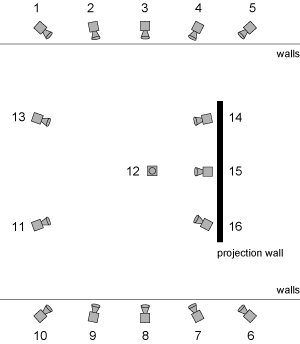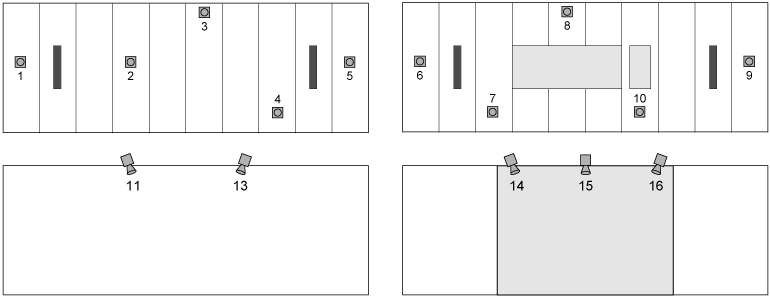







| Real-World Test Sequences | ||||||||
IntroductionHere, we provide interested researchers a real-world multi-view test data set captured in the blue-c portals. The data is meant to be used for testing reconstruction/rendering algorithms based on multi-view video sequences with consideration of noise and other capturing device errors. Furthermore, it can be used for testing streaming and compression techniques since we are also providing depth maps as calculated by a shape-from-silhouettes method. The set consists of frame sequences rendered from 16 different camera views located in a hemisphere around the scene, background images, segmentation masks, depth images, and camera parameters. The recorded scene contains different humans performing various motions, ranging from simple and slow movements to kicks and punchs of a Kung-Fu fighter. The sequences have different lengths and are recorded at different acquisition frame rates. Each frame is saved as a 640 x 480 image. Here is an illustration of the blue-c portal at ETH Hönggerberg where all sequences are captured. The numbers indicate the camera nodes (i.e., arctic1 - arctic16). Bird's eye:
Side views:
Quicktime VR inside-out:DownloadTest sequences are available upon request. Please write to wwwgraph inf.ethz.ch for more information. inf.ethz.ch for more information.
Camera CalibrationCalibration data from our multi-camera self-calibration procedure can be found here. You can also do your own calibration by downloading the calibration sequence. The parameters are stored according to:
We also provide graphical outputs for understanding the setup and calibration accuracy (which is mostly around 0.2 pixels reprojection error). Download calibration data | ||||||||
| MPEG Test Sequences | ||||||||
Lara Sequencea.k.a. "Kung-Fu Girl". You can find the MPEG synthetic data set provided by the
GrOVis group of the
Max-Planck-Institut für Informatik at:
The data is meant to be used for testing reconstruction/rendering algorithms based on multi-view video sequences without consideration of noise and other capturing device errors found in real-world data. The set consists of frame sequences rendered from 25 different camera views located in a hemisphere around the scene, background images and camera parameters. The recorded scene contains a humanoid figure, animated by motion-captured data, and is rendered in three flavours: foreground with textured, shaded and empty backgrounds respectively. In addition, they also provide a pure silhouette set. The sequences are 200 frames long and each frame is saved as a 320x240 image. |



